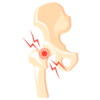Hip cold
What is a hip cold?
The "hip cold" is a temporary and acute inflammation of the hip joint, which manifests itself by a sudden limp and difficulty in walking. It is also called "transient acute hip synovitis". It is the most common cause of lameness and acute hip pain in children under the age of 10.

The hip
The hip is defined as the joint that forms the junction between the trunk and the lower limbs. The hip is therefore the joint that connects the femur bone to the iliac bone (pelvic bone).
Who is affected by hip colds?
Hip colds are common, with about 2 cases per 1000 children aged 3 to 10 years each year. The majority of patients, 70%, are boys.
What are the signs of a hip cold?
The signs of a hip cold are easily recognizable:
- Sudden onset, without apparent cause.
- The pain is usually felt in the morning upon awakening in a lower limb,
- The pain can be localized or diffuse and the patient. It can be located in the hip, knee or anteromedial aspect of the thigh.
- The patient may have difficulty walking, limping but walking is possible in the vast majority of cases.
- Note: in 10% of cases, no pain is present.
What causes a hip cold?
The cause or etiology is unknown.
However, cases of upper respiratory tract infections that occur in the days leading up to it are often noted.
Diagnosis of hip colds
- It is the clinic that essentially makes the diagnosis because the symptoms are typical. Mobilization of the hip may be painful and reduced in amplitude, especially for abduction and internal rotation movements.
- Blood test: CBC-SV-CRP: no significant inflammatory syndrome (normal leukocytes, moderately increased or normal VS and CRP).
- Ultrasound: in some cases, ultrasound shows an accumulation of fluid within the joint.
Differential diagnosis:
When faced with a hip cold, the following pathologies should be eliminated:
- Septic arthritis;
- Perthes' disease;
- Osteomyelitis, etc.
Treatment of hip colds
The treatment of hip colds consists of:
- Relative rest: immobilization is not necessary, but rest is recommended, if only to avoid pain when walking
- Analgesics such as doliprane in case of pain
- NSAIDs after a bacterial cause has been formally ruled out.
Evolution and follow-up
Symptoms usually last about 10 days but can last up to 3 weeks and the prognosis is excellent, with no long-term sequelae.
Relapses (2-3) are possible on the same or the 2nd hip.
Follow-up should be performed 2 weeks after diagnosis to ensure that there is no recurrence of joint effusion or progression to avascular necrosis.
Osteopathy and hip colds?

As you have understood, a hip cold heals spontaneously. However, it is strongly advised to consult an osteopath 2-3 weeks after the occurrence of this pathology.
- The child with a limp will have set up compensation mechanisms on the rest of the body and it is the osteopath's role to treat the repercussions of this limp.
- Often after a hip cold, the child keeps a limp "of habit" or protection. The osteopath, through his manipulations and exercises, will allow your child to no longer be apprehensive about walking normally.
Marie Messager
Osteopath D.O
2 rue Alexis de Tocqueville
78000 Versailles

